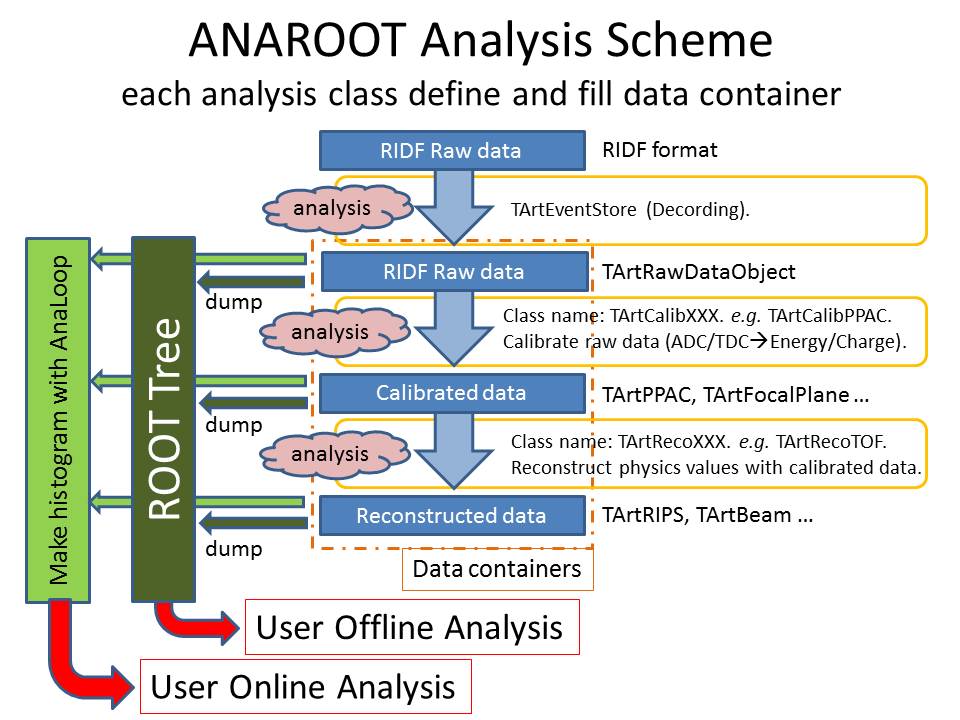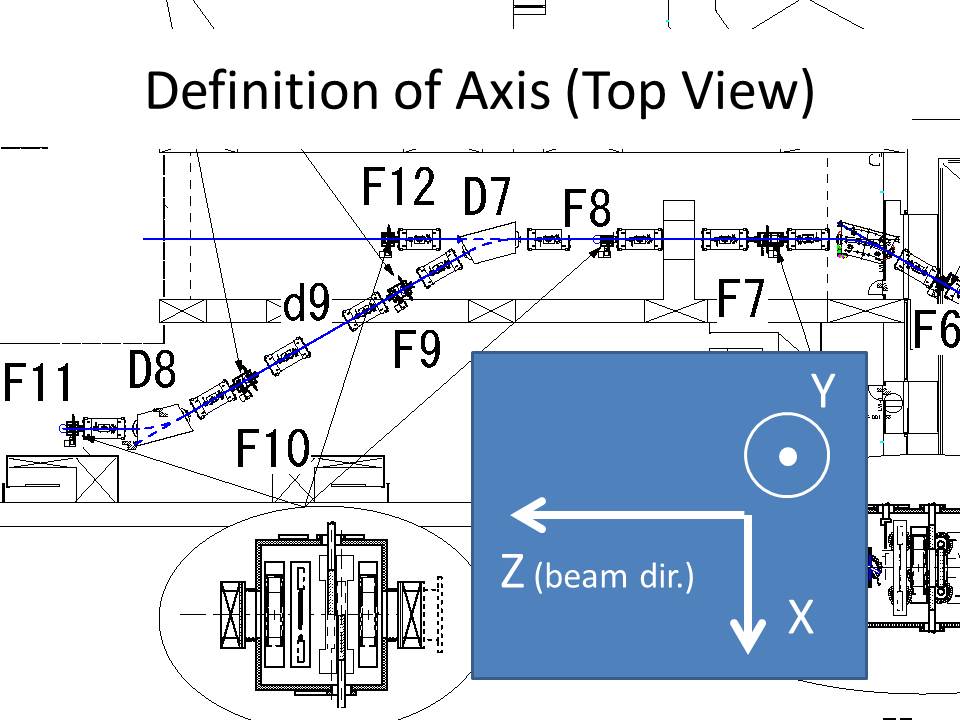Structure of ANAROOT library
- source/Core core libraries for decoding RIDF, and some base classes, such as TArtStoreManage. - source/Reconstruction libraries for reconstruction of data from each devices - source/Reconstruction/BigRIPS libraries to calibrate raw data of BigRIPS detectors, such as PPAC, Plastic, IC and Ge. library to reconstruct beam A/Q and Z - source/Reconstruction/DALI libraries to calibrate raw data of DALI NaI detectors - source/Reconstruction/SAMURAI libraries to calibrate raw data of SAMURAI detectors, such as BDC1/2, FDC1/2, HODF/P, ICF and NEBULA - source/Reconstruction/EURICA libraries to calibrate raw data of beta decay spectroscopy detectors - source/Nadeko libraries for anapaw like command line - source/AnaLoop libraries for user wise data analysis routine
Architecture of analysis routines
Each reconstruction library has each main and sub routine to analyze the raw data.
It is named as "TArtCalibXXX" and "TArtRecoXXX". We expect three step analysis routine for user to access the calibrated and/or reconstructed data.
Each analysis routine fill the data container which is defined by each analysis routine when its class is constructed.
Special class of "TArtStoreManager" manages the data container I/O and analysis parameter I/O. Each TClonesArray of data container is registered by analysis object and the data container is accessible through the pointer given by TArtStoreManager. Please check TArtStoreManager.hh for the functionality of data manager.
Data Structure
Reconstructed data by ANAROOT are composed in TClonesArray ROOT Class. Followings are some data container classes defined in ANAROOT and array of each data container is expected to be handled by user.
Event Information such as event number, Trigger bit and Time-Stamp.
- TArtEventInfo
Beam related data container, most of them are made by BigRIPS libraries.
- TArtPPAC - TArtIC - TArtPlastic - TArtFocalPlane - TArtTOF - TArtRIPS - TArtBeam
DALI related data container.
- TArtDALINaI
SAMURAI related data container.
- TArtDCHit - TArtDCTrack - TArtHODPla - TArtICF - TArtNEBULAPla - TArtNEBULAHPC
EURICA related data container.
- TArtNaI - TArtGeCluster - TArtSiStopper - TArtSiStopperChain
The structure of decoded data provided to user is different from other data, which is TArtRawEventObject.
TArtRawEventObject is just the decoded object which consists of run number, event number, time stamp information and the array of data of segment which is named TArtRawSegmentObject.
The data of segment is the segment which is defined in RIDF data format.
The detail of the parameters in TArtRawSegmentObject is can be referred at DAQ/Manual/Dataformat.
TArtRawSegmentObject consists of sort of device ID and each data, TArtRawDataObject.
- TArtRawEventObject - TArtRawScalerObject - TArtRawSegmentObject - TArtRawDataObject
User defined parameters
ANAROOT is expected to read user defined parameters written in XML format.
XML file can be produced through several kinds of software: Microsoft Access, Excel, Open Office and google spread sheet.
Mapping for user analysis
ANAPAW use the Map file for user analysis. Same format map file can be used for the mapping of the data just with loading the Map file in your Macro using following function:
TArtEventStore::LoadMapConfig(char *);
When you scan your file after you load the map file, detector category # (PPAC? Plastic? Dali?), detector # and datatype (Tx1? TA?...) can be extracted with the functions of:
TArtRawDataObject::GetCategoryID();
TArtRawDataObject::GetDetectorID();
TArtRawDataObject::GetDatatypeID();
The macro of CheckBLDet.C check the detector category number and inform you what kind of data for BigRIPS beam line detectors are saved
Definition of axis
It is recommended to use common definition of xyz axis as shown in following.
ANAROOT in Go4
Go4 is object orientad framework developed at GSI.
web site for Go4 ANAROOT library can used in Go4 framework and it is useful for online data analysis.
ANAROOT library can used in Go4 framework and it is useful for online data analysis.
Currently, the source code for using ANAROOT in Go4 is develoment version. If you would like to try to use it, go to Tools/Analysis/ANAROOT/Go4.

